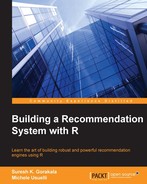In many situations, we are able to build different collaborative and content-based filtering models. What if we take account of all of them at the same time? In machine learning, the approach of combining different models usually leads to better results.
A simple example is collaborative filtering combined with information about users and/or items. In the case of IBCF, the distance between items can take account of user preferences and item descriptions at the same time. Even in UBCF, the distance between users can take account of their preferences and personal data.
In the case of recommendation, these models are called hybrids. There are different ways to combine filtering models.
Parallelized hybrid systems run the recommenders separately and combine their results. There are a few options such as the following ones:
- Define a rule to pick one of the results for each user. The rule can be based on the user profile and/or on the recommendation.
- Compute an average of the rankings. The average can be weighted.
Pipelined hybrid systems run the recommenders in sequence. The output of each model is an input for the next.
Monolithic hybrid systems integrate the approaches in the same algorithm. Some options are as follows:
